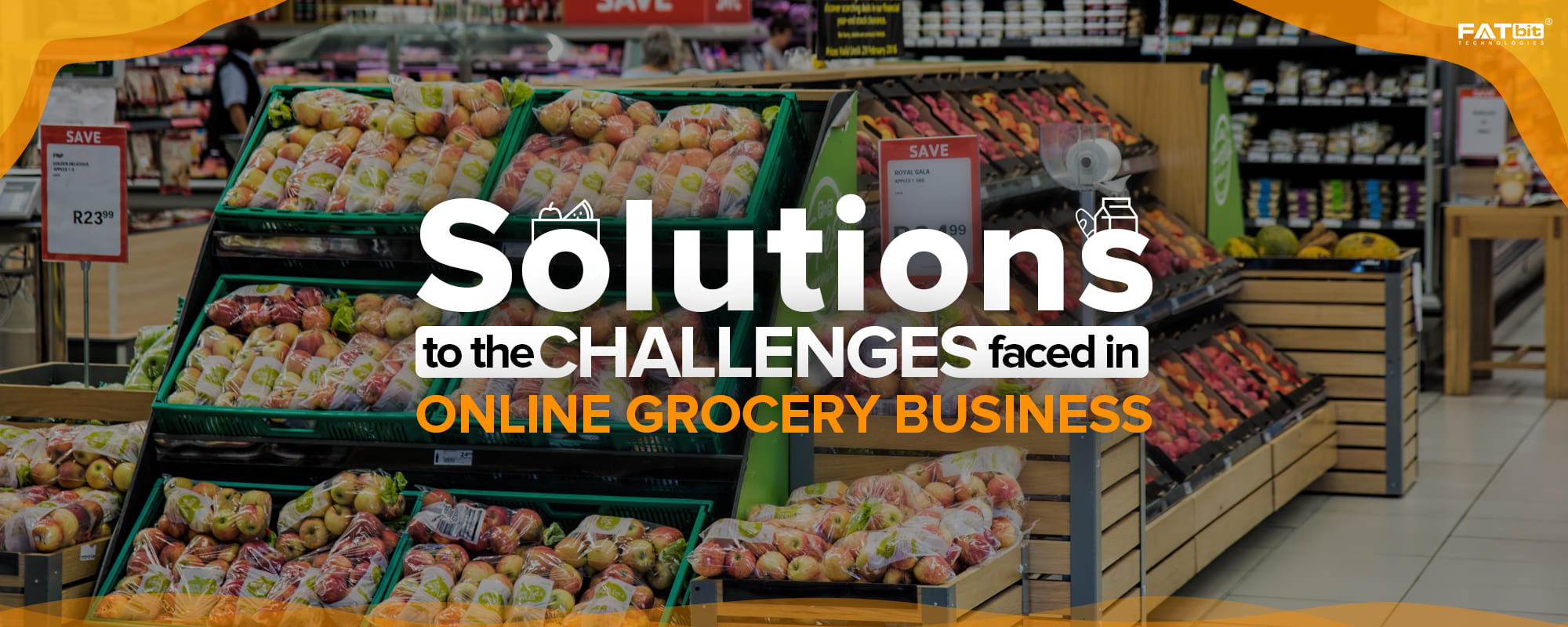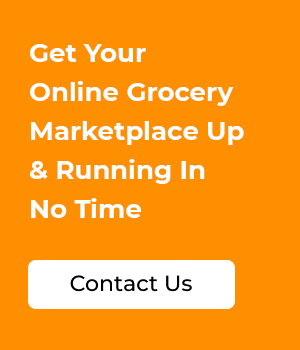Last Updated: 19th September, 2023
According to Statista, the US online grocery market is booming with projected sales to reach 187.7 Billion U.S. dollars by 2024. With such an increase in demand for online grocery, retailers and entrepreneurs have been venturing into the digital world. But there are a number of challenges faced by online grocery businesses. In this post, we share the same and discuss the possible solutions.
Table of Contents
Challenges Faced by Online Grocery Stores and Their Solutions
Poor Inventory Management
The lifeline of any business is getting the products to the customers on time. And staying ahead of the game by properly managing the inventory efficiently helps meet the demand and generate sales. But several startups and well established only grocery businesses face concerns regarding inventory management. Many of them consider spoilage and lost inventory as part of their business, but for some the costs of poor inventory management can be really high.
Solution
The problem can be resolved through an inventory management system. If you already use an online grocery ordering and delivery software, customizations might be possible to develop a new module to prevent the lost inventory and address the wastage problem. Just-in-time supply systems integrated with state-of-the-art grocery inventory management API can minimize inventory costs to an extent.
Inefficient Delivery Management
Inefficient delivery management is one of the most common challenges that can have a lot of negative consequences. These include order delays, customer dissatisfaction, higher cost and more. In addition, bringing visibility to the last mile delivery is critical but it heavily depends on the delivery executives.
Solution
For consumers, delivery of quality grocery products in less time is supremely important. Hence, the automation of delivery processes through a grocery delivery software can improve order fulfillment efficiency and further increase customer satisfaction and productivity. Moreover, it can help in determining the shortest delivery route and with real-time visibility of the fleet, it can enhance customer satisfaction with order tracking.
Looking for a Feature-Rich Online Grocery Delivery Solution?
Changes in Tax
Every business has dependency on government policies and regulations. There are times when changes are proposed and government policies and regulations are modified. Keeping up with the taxes can be a vexing challenge as any fluctuation can bring in a bad name to the business because the prices of the products are directly affected.
Solution
To overcome this challenge, businesses have to stay updated and the same needs to reflect on the grocery ordering and delivery system as well. While a small business needs few changes, large grocery chains can adopt a more proactive approach to tax management from their existing system. There are two ways this can be achieved. The first one requires less time and includes integration with a third party tax management system like TaxJar or Avalara. Alternatively, a tax management module can be developed from scratch but may require more time.
Changing Consumer Behaviour
There has been a seismic shift in the mindset of consumers and their choices over the past few years. They have less time, but are increasingly seeking healthier products and convenience. Hence, to keep pace with the evolving preferences of consumers, grocery retailers must be prepared.
Solution
As the consumer behavior is constantly changing and the grocery eCommerce market is constantly growing, to succeed in such a competitive market, a marketing strategy is required. To support the strategy, the grocery ordering and delivery software should come pre-installed with important marketing features. For example – to send newsletters, the system should have a newsletter management feature. Similarly, for a grocery business to stay profitable, other marketing capabilities are required such as blog module, discount coupon code generation, affiliate management, paid advertising management, and more. Furthermore, having mobile apps greatly improves the experience of consumers.
Small towns or tier 2 or 3 cities have a close-knit community which have different market dynamics. For example, in a certain neighborhood, consumers still prefer going to the same vendor with a brick and mortar store. Hence, it gets difficult to penetrate in small towns.
Solution
The primary step is to conduct market research and after carefully analyzing the area and its challenges, you can finalize the business model – single vendor or multi vendor. Based on the selection of the business model, you can either start selling your own grocery items or onboard vendors. In the latter case, you need to devise vendor onboarding strategy and make it worthwhile for the vendors to list their products on the website.
High Marketing Costs
For any business, marketing helps build their brand and grow their customer base. But the actual cost of marketing can be high as it depends on a handful of factors such as advertising, market research, promotions and so on.
Solution
An online grocery delivery solution that has inbuilt marketing features can help streamline marketing efforts and efficiently reduce the costs associated with it. For example, if the goal is to reach out to people who are registered members of the online store, then the email marketing feature can be used to share relevant information.
Non-availability of Mobile Apps
In the online grocery shopping ecosystem, speed and convenience are of the top most priority. And mobile apps provide these possibilities to consumers under their hands. Out of the different touchpoints for an online grocery delivery business, mobile apps have become an essential part of the grocery delivery system. Unavailability of the same can hamper the growth of the business immensely.
Solution
Mobile apps add value to any business, so having mobile apps that fit your vision are a must have in the present day scenario of m-commerce. According to market research, the m-Commerce market is expected to reach $4,711.9 Billion by 2027. Hence, if you are an entrepreneur who runs an online grocery delivery business or is planning to start one, it is important to get the mobile apps by either having them developed or by opting for a solution that provides ready-made grocery buying and delivery apps.
For example – by using the buyer mobile app, a buyer may place an order for groceries. Similarly, by using the delivery app, the delivery staff may update the real-time status of the grocery order.
Need Grocery Delivery Apps for your Business?
High Operational Costs
When an online grocery business starts, operational costs will likely be higher. Gradually they need to be controlled. But if the costs are not managed and continue to remain high, then the situation becomes worrisome as it represents a loss in the revenue.
Solution
High operational costs can drag down an online grocery business and can be a major challenge. To overcome this challenge, it is important to have smart management strategies and an online grocery delivery system that automates the business processes and makes the delivery of groceries hassle-free.
UI/UX Issues
An online grocery delivery marketplace is all about offering seamless shopping experiences to the buyers. Not having an adequate design foundation can pose a big challenge to a smooth checkout process. This includes lousy navigation, inconsistent design elements, poor layout and so on.
Solution
User experience design is the key to the success of an online grocery delivery business as it will take a user from Point A to Point B that will ultimately result in a smooth checkout process. This can be achieved by hiring experienced UI/UX designers or opting for a ready-made solution that has a user centered design.
Low System Security
Compromised security is a very big challenge. It can jeopardize the integrity and confidentiality of data including payment information of users. Implementing security measures to prevent data breaches is a big concern for an online grocery business.
Solution
Making the online grocery delivery system secure is a must to keep the customers financial and nonfinancial information safe. Hence, opting/migrating to a grocery delivery software that is SSL, PCI, GDPR compliant is the solution.
Time is the most important factor and if a website takes a lot of time to load, then the individuals will shift to the competitors’ site and the online grocery business will lose its sales. Market studies show that conversion rates can drop by 7% if there is a 100-millisecond delay in load time.
Solution
Page speed optimization is a solution to having a sterling website performance. There are various techniques to do the same. But hiring professionals or a grocery eCommerce development company is the way forward. We at FATbit Technologies have a proven track record of optimizing websites for speed issues.
Learn How Growcer will Help You Overcome Online Grocery Business Challenges
Conclusion
The online grocery industry is growing by leaps and bounds due to the transition of consumers to online shopping. Hence, with an increase in online shopping, it is natural to face challenges as a grocery retailer. For many of the challenges which we have discussed above, a competent online grocery software like Growcer is the solution. For more information, you can get in touch with us.

